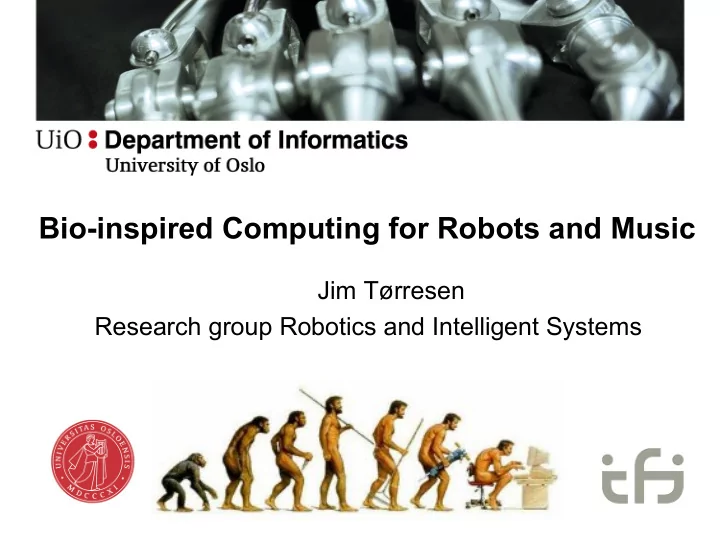

Bio-inspired Computing for Robots and Music Jim Tørresen Research group Robotics and Intelligent Systems
Robotics and Intelligent Systems
Robotics and Intelligent Systems (ROBIN) Jim Tørresen Postdocs: Professor, Group leader Charles Martin Enrique Garcia-Ceja Mats Høvin Kai Olav Ellefsen Assoc. Prof. Md. Zia Uddin Weria Khaksar Kyrre Glette Assoc. Prof. PhD students: Kristian Nymoen Arash Ahmadi (MedFak) Assoc. Prof. Asbjørn Danielsen (UiT) (shared with music dep) Benedikte Wallace Eivind Samuelsen Yngve Hafting Farzan Noori Ass. Prof. Flavia Dias Casagrande (HIOA) Vegard D Søyseth Justinas Miseikis Principal Engineer Jørgen Nordmoen Sondre Engebråten (FFI) Adjunct positions (20%): Tønnes Nygaard Alexander Wold (assoc.prof.) Students Bachelor ~60; Master: ~45 Michael Riegler (researcher) Robotics and Intelligent Systems program Roar Skogstrøm (lecturer) Ståle Skogstad (assoc.prof.) Students hired on hourly basis Ole Jakob Elle (assoc.prof.) Visiting researchers (Brazil)
Robotics and Intelligent Systems group ROBIN Creating systems for Robotics and Hardware demanding run-time Intelligent environments Electronics Systems 3D-printing Prototyping Applications Biology Robotics Apply Music principles Health from nature ++ Web page: Google for ”ROBIN IFI”
Robotics and Intelligent Systems research 5
ROBIN • Methods: Bio-inspired – Evolutionary computation – Machine learning/deep learning – Prediction – Self-awareness • Applications: – Adaptive and evolutionary robotics – Robotic surgery and robots for elderly – Music technology – Mental health support – Reconfigurable (evolvable) hardware
EPEC: Prediction and Coordination for Robots and Interactive Music Research Council of Norway grant 240862. Goal: Design, implement and evaluate multi-sensor systems that are able to sense, learn and predict future actions and events.
State-of-the-art Rapid Prototyping Facilities • 3D printers and milling machines • Large potential for developing innovative robot systems.
Robot Design, Simulation, Assembly and Evaluation - Work with real robots and simulations. - Reduce gap between simulation and reality. - Create novel methods for design (e.g., evolution) and dynamic body shapes (morphology).
Evolved Control Systems • We can evolve movement patterns! – Parameterize periodic functions for each joint – Evolve all those parameters 12
Evolved Robot Design • Robot bodies could be difficult to design by hand. • We use evolutionary algorithm to evolve both body and control system simultaneously. 13
Video Reuters http://uk.reuters.com/video/2015/06/15/3d- printed-robots-adapt-themselves-to- th?videoId=364592612 15
Dyret: A low-cost self-modifying quadruped - Our most advanced legged robot to date - Used for evolutionary experiments and research in self modelling and control - Used in master’s projects.
18
19
Robot Surgery (Oslo University Hospital) Ole Jakob Elle (ROBIN) 2. november 2018 20
Environment Aware Robot for Hospitals Goal: allow the fluoroscopy (C- arm) and ultrasound robots to coexist in surgery room without having any direct communication 3D cameras are used to identify and detect robots in the surgery room UR5 robot tries to adapt to changes in the environment and move out of the way when needed
MECS: Multi-sensor Elderly Care Systems Research Council of Norway grant 247697 Goal: Create and evaluate multimodal mobile human supportive systems that are able to sense, learn and predict future events . http://www.mn.uio.no/ifi/forskning/prosjekter/mecs
Elderly Care with Robot Companion • Move from permanent and fixed room surveillance to flexible and adaptive – Increased privacy – Increased accuracy • Active testing involving real environments • Detect and predict falls and other non- normal situations to notify caregiver . – In emergency situations, the robot – rather than the elderly – activates the safety alarm . 25
26
MECS Research User needs and preferences Robot control Robot sensing 27
Navigation without a Map - Having a mobile robot with 3D camera and/or Lidar. - Moving in a completely unknown environment. - Using the sensory information to build the path and navigate. - Employing several AI tools including Fuzzy Logic and Genetic Algorithm Challenge: - Finding computationally cheap solutions with high quality.
Real-time Tracking, Segmentation, and Modelling - Deep Learning for body skeleton tracking in real-time. - 3-d body modeling in real-time.
Real-time Face Tracking - Face tracking in real- - Face tracking in real- time using RGB time using thermal camera on a robot. camera on a robot. - Works well when - Works well even in there is enough light. the dark.
Ultra-Wide Band (UWB) radar sensor see through walls 34
INTROMAT: INtroducing personalized TReatment Of Mental health problems using Adaptive Technology (2016-2022) Goal: Increase access to mental health services for common mental health problems by developing smartphone technology which can guide patients . http://intromat.no Funding: IKTPLUSS Lighthouse, Research Council of Norway
Mental health monitoring (INTROMAT) Analysis of sensor and behavioral data with • machine learning. Mental states prediction for bipolar, anxiety and • attention-deficit/hyperactivity disorders. Use of smartphones, wristwatches and virtual • reality devices to monitor users´ behavior. Adapt clinical follow up and activate automatic • treatments when needed. Mental state Speech, motion, heartbeat, Machine learning phone usage etc
5 cases • Relapse prevention for bipolar disorder • Cognitive training in Attention Deficit Hyperactivity Disorder ( ADHD ) • Job-focused treatment for depression in adults • Early intervention and treatment for social anxiety disorder in adolescents • Psycho-social support for women recovering from gynecological cancer .
International Collaboration 39
Study Abroad? – Master Project in Brazil, Japan or US • Funding available for selected students to do two semesters abroad for master thesis work. Apply at/before November 1 • Funding through collaboration projects (2017–2019) between ROBIN at University of Oslo and partners in Brazil, Japan and (US) • Cover: Travel + monthly scholarship of NOK 6000 http://www.mn.uio.no/ifi/studier/masterop • Interested? See: pgaver/robin/study-abroad-coinmac.html 2. november 2018 40 Contact: Jim, e-mail: jimtoer@ifi.uio.no
9th Joint IEEE International Conference on Development and Learning and on Epigenetic Robotics 19-22 August 2019, Oslo, Norway Web page: https://icdlepirob2019.wordpress.com Call for Papers/Workshop/Tutorials 41
https://youtu.be/m5yu2BimALk 42
Recommend
More recommend